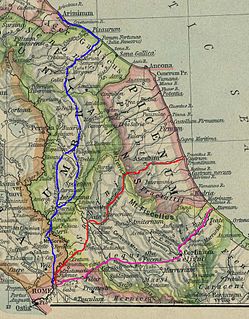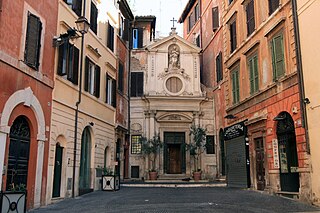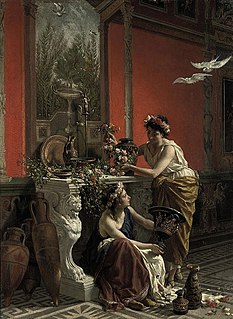San Lorenzo is a district ( quartiere ) in Rome, Italy.
A quartiere is a territorial subdivision of certain Italian towns. The word derives from quarto, or fourth, and was thus properly used only for towns divided into four neighborhoods by the two main roads. It has been later used as a synonymous of neighbourhood, and an Italian town can be now subdivided into a greater number of quartieri. The Swiss town of Lugano is subdivided into quarters also.

Rome is the capital city and a special comune of Italy. Rome also serves as the capital of the Lazio region. With 2,872,800 residents in 1,285 km2 (496.1 sq mi), it is also the country's most populated comune. It is the fourth most populous city in the European Union by population within city limits. It is the centre of the Metropolitan City of Rome, which has a population of 4,355,725 residents, thus making it the most populous metropolitan city in Italy. Rome is located in the central-western portion of the Italian Peninsula, within Lazio (Latium), along the shores of the Tiber. The Vatican City is an independent country inside the city boundaries of Rome, the only existing example of a country within a city: for this reason Rome has been often defined as capital of two states.

Italy, officially the Italian Republic, is a European country consisting of a peninsula delimited by the Italian Alps and surrounded by several islands. Located in the middle of the Mediterranean sea and traversed along its length by the Apennines, Italy has a largely temperate seasonal climate. The country covers an area of 301,340 km2 (116,350 sq mi) and shares open land borders with France, Slovenia, Austria, Switzerland and the enclaved microstates of Vatican City and San Marino. Italy has a territorial exclave in Switzerland (Campione) and a maritime exclave in the Tunisian sea (Lampedusa). With around 60 million inhabitants, Italy is the fourth-most populous member state of the European Union.
Contents
It occupies roughly the two sides of the early stretch of Via Tiburtina, starting from Termini railway station and ending at the Verano area. The latter includes the ancient basilica of San Lorenzo fuori le Mura, which the district takes its name from.

Via Tiburtina is an ancient road in Italy leading east-northeast from Rome to Tivoli and then on to Pescara.

The Campo Verano is a cemetery in Rome, Italy, founded in the early 19th century. The cemetery is currently divided into sections: the Jewish cemetery, the Catholic cemetery, and the monument to the victims of World War I.

The Basilica Papale di San Lorenzo fuori le Mura is a Roman Catholic Papal minor basilica and parish church, located in Rome, Italy. The Basilica is one of the Seven Pilgrim Churches of Rome and one of the five former "patriarchal basilicas", each of which was assigned to the care of a Latin Church patriarchate. The Basilica was assigned to the Patriarchate of Jerusalem. The Basilica is the shrine of the tomb of its namesake, Saint Lawrence, one of the first seven deacons of Rome who was martyred in 258. Many other saints and Bl. Pope Pius IX are also buried at the Basilica, which is the center of a large and ancient burial complex.
Originally a working-class neighbourhood (its inhabitants were mostly workers of the Wuehrer Brewery and the freight yard), it has been a popular, left-oriented area. During World War II San Lorenzo was heavily bombed by Allied planes (on 1943-07-19); the only massive bombing of Rome during the war (though not the only air raid on the city), it aimed at disrupting the railway communication pivoting on the nearby huge freight yard; however, it caused also extensive damage to the buildings of the district (including the Policlinico Umberto I and the basilica itself) and killing some 1,500 people.

World War II, also known as the Second World War, was a global war that lasted from 1939 to 1945. The vast majority of the world's countries—including all the great powers—eventually formed two opposing military alliances: the Allies and the Axis. A state of total war emerged, directly involving more than 100 million people from over 30 countries. The major participants threw their entire economic, industrial, and scientific capabilities behind the war effort, blurring the distinction between civilian and military resources. World War II was the deadliest conflict in human history, marked by 50 to 85 million fatalities, most of whom were civilians in the Soviet Union and China. It included massacres, the genocide of the Holocaust, strategic bombing, premeditated death from starvation and disease, and the only use of nuclear weapons in war.

The bombing of Rome in World War II took place on several occasions in 1943 and 1944, primarily by Allied and to a smaller degree by Axis aircraft, before the city was invaded by the Allies on June 4, 1944. Pope Pius XII was initially unsuccessful in attempting to have Rome declared an open city, through negotiations with President Roosevelt via Archbishop Francis Spellman. Rome was eventually declared an open city on August 14, 1943 by the defending forces.
Located in the Quartiere San Lorenzo, the Policlinico Umberto I of Rome is the polyclinic of the Faculty of Medicine and Surgery of the Sapienza Università di Roma. The second largest public hospital in Italy, its construction was mainly promoted by Italian physicians and politicians Guido Baccelli and Francesco Durante and began in 1883 to plans by Giulio Podesti and Filippo Laccetti, and was completed 20 years later, with the opening presided over by the then rector Luigi Galassi and by Umberto I of Italy, after whom it is named. It is served by the Policlinico Metro station.
Maria Montessori's first 3-6 age program was started in San Lorenzo in 1907.
Today San Lorenzo, due to the vicinity of the La Sapienza University, is increasingly assuming the character of a student and young artist district. Every evening, hundreds of young people descend on the area, much to the chagrin and protests of the inhabitants of the area. Pizzerias, bookshops, boutiques and other modern places are subsequently replacing the old popular workshops and small markets.













